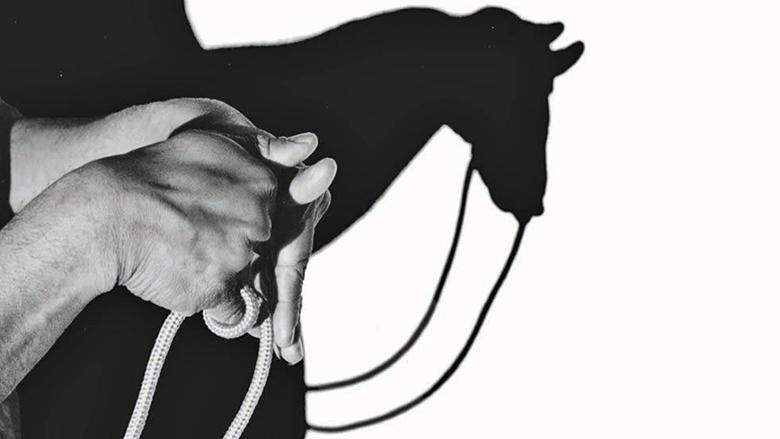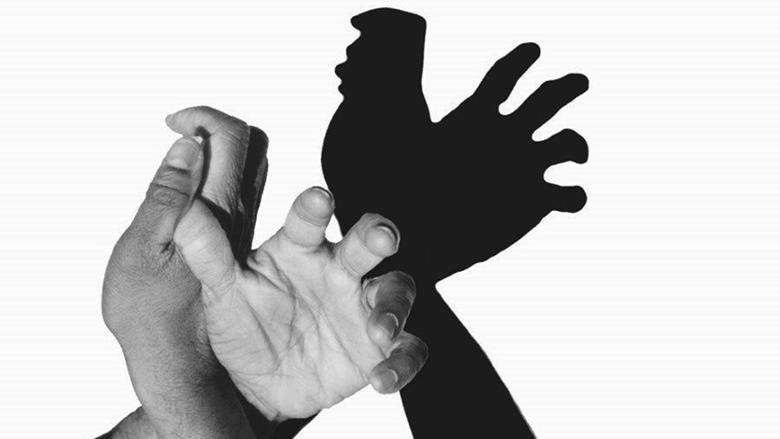Banker by day, Mr Entertainment by night
In between work for the World Bank, Sati Achath goes places with his hilarious performances blending ventriloquism, hand shadows, magic and music
There’s a little party going on in Sati Achath’s home, and he is all keen to make the introductions. ‘Let’s start with Kishore,’ he says, waving his hands towards the man closest to him, and I turn towards a young man with a disarming, mischievous smile. ‘Don’t be fooled by that sweet grin!’ Sati exclaims immediately. ‘He’s the king of mockery and insults.’
Sitting next to Kishore is Shilpa – who he introduces as ‘a Bollywood singing sensation – she’ll sing for you later.’ Next is Toms, who ‘claims that Donald Trump and Narendra Modi are his close friends and they consult with him on national and international affairs.’ Then there’s Dr Charlie D’Souza – ‘I still don’t know if he deserves the Dr before his name,’ says Sati.
The introductions go on for a few more minutes, until I have met all 10 of his friends, each one presented with their quirks and foibles.
Sati’s enthusiasm is so contagious, I almost wave at each of his friends. Which would be silly, considering they are puppets sitting side by side.
They come in all shapes and sizes and outfits – one’s wearing a traditional Indian outfit, another is in a three-piece suit. Yet another is in a dishevelled set of shirt-tie-trousers and hair that looks as though it’s undergone an unfortunate electric shock – it’s clear this particular puppet has had a very rough day.
Sati, however, has not. A ventriloquist (among several other things), he moves behind a white screen, arranges his fingers in some fashion and I catch the silhouette of Donald Trump. In a flash the fingers rearrange themselves to display a horse, reins and all, and then a camel.

Ask Sati to run through his hobbies, and he’ll ask how much time you have on your hands – even if he’s planning to give you a very quick recap. And I soon find out why. The 67-year-old has mastered so many arts, it’s a conveyor belt of entertainment.
First there’s the shadowgraphy, where via hand shadows he produces a portfolio of about 50 animals and 100 personalities. Then there’s the ventriloquism, where he has about 12 puppets that talk. Then there’s the magic, with the rope tricks and newspaper water tricks. The cartooning and caricaturing. And the music, from the mouth organ, flute and harmonica to the tabla and saxophone. It’s a box of tricks that keeps on giving.
[There’s magic in the air when illusionist Ahmed Al Bayed steps on stage]
They’re a distinctive set of acts – no imposing effects, just centuries-old art forms. No grand-scale stage illusions, no snake escapology, but simple, primitive forms of entertainment that bank on imagination as much as anything else. ‘These are simple yet highly entertaining arts,’ Sati reaffirms. ‘And I’m a one-man army dabbling in all of them, fighting to keep them alive.’
Seeing as his art has taken on such a multifaceted route, it was only plausible that his life had followed such a versatile path too. Originally from the southern Indian state of Kerala, he grew up in Thrissur, worked in a bank, joined the IRS, got a French scholarship to do a master’s in international relations, applied for admission to a US university, received an MBA from the US, moved to Washington, and started working for the World Bank, where he has been for the last 26 years.
His job as a project evaluation specialist (whenever a World Bank project closes, he flies to the location for an evaluation and prepares a project completion report) involves a lot of travel – he has visited over 70 countries. So Sati decided pursuing his hobbies based out of different countries was the way forward. ‘The flexibility to move from my Washington headquarters meant balancing my professional and personal pursuits wasn’t that tough – it was a great privilege to be able to have that freedom,’ he says. At the time of our interview, Sati had been in Dubai a few months ‘to test the waters’ for exploring his talents. He was readying to go to Indonesia a week after. Right before that he had been in Tajikistan, and Lesotho before that for World Bank work. ‘It’s great to be able to visit so many countries as part of work, and explore the appetite for my hobbies there at the same time,’ he says.
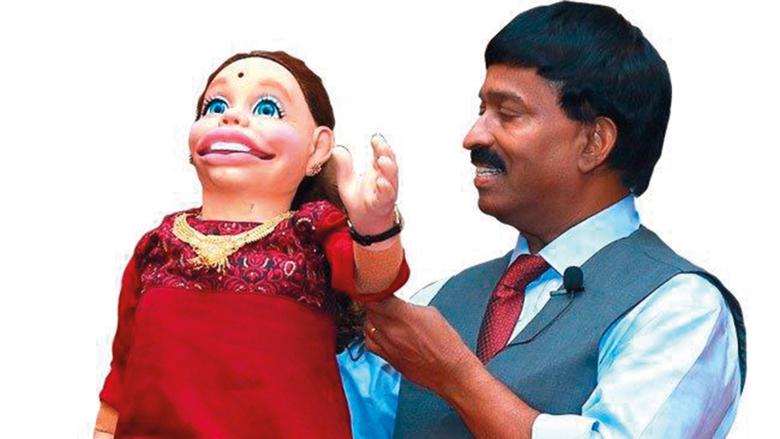
Ask him to produce a hand shadow of any personality worldwide and he’ll oblige. He started with India’s former Prime Ministers Indira Gandhi and Vajpayee, and now he’s updated that list to include Donald Trump. There’s Reagan, Nixon, Obama, Modi – he talks of how in the current climate politicians have become more interesting to develop, ‘though I also do everyone from Michael Jackson and Brad Pitt to actor-director Dev Anand.’
But his father’s shadow forms the real influence in his work. Even as he was drawing, painting and illustrating as a child, Sati learnt hand shadows from his father CK Menon. ‘Dad developed it during his job with the Kerala government, when he was posted in the district of Palakkad away from our family. All alone in a room, missing his family and with so much time on his hands, he started experimenting with the light falling on the wall, and started developing his own repertoire of shadows.’
Fascinated when his dad showed them the shadows at home, Sati cajoled his dad to teach him, and slowly started learning how to make shadows of various animals and personalities. It’s a passion that would culminate in him writing a book years later when he moved to the US. Called Fun with Hand Shadows, it immediately received wide coverage – ‘I was getting mail from Sweden to Australia’ – and which he dedicated to his father, who didn’t live to see it published.
In hindsight, he’s glad he took up shadowgraphy when he did – ‘I have nine siblings, but out of us 10, I am the only one who pursued it.’ As one of the very few practitioners of an art form that finds its origins in China thousands of years back, his lack of interest would have meant another death knell for shadowgraphy.
‘Yes, there was a stage when hand shadows were a dying art,’ he nods, ‘hardly anyone knew about shadows previously.’ But he thinks that phase has safely passed. ‘This fear was actually a massive incentive for me to publish the book – had I not, the art would have more or less disappeared.’ Might there actually be a resurgence on our hands? He nods. ‘There’s lots of fun YouTube videos on hand shadows now, and I find more people expressing an interest in learning it – and I teach it to whoever is interested.’
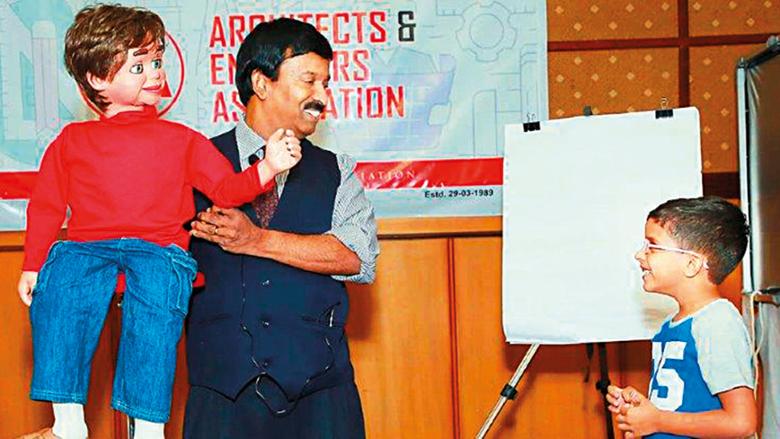
He also started specialising in cartooning and caricaturing, drawing for Indian Express and other newspapers in India, and in the US, has syndicated his caricatures to about 25 national newspapers, from the Washington Post to Chicago Tribune.
But his big break in the US was yet to come – and it came with an appearance in The Late Show with David Letterman in 1996, overnight helping turn the spotlight firmly on him and his art. ‘Letterman served as a passport to all my artistic pursuits,’ he says. Soon after his display of hand shadows on the show, ‘people were crowding for my autograph, like I was a Hollywood celebrity.’ He recounts how ‘even now Americans recognise me from the show.’
Fame didn’t stop there, and along came his next big appearance a few years back, qualifying as a quarter-finalist in talent show America’s Got Talent. Though he didn’t win, he calls it a fantastic experience that gave more prominence to hand shadows as an art. ‘It was a gathering of so many artists staying together, exchanging ideas, rubbing shoulders with celeb judges. I crossed 7-8 rounds, but hand shadows have a limitation to what you can show, at one stage you reach a saturation so I couldn’t get further.’
Despite his minor celebrity status, he’s modest about it. ‘I’m just happy I could continue my father’s legacy. He’d never have thought his art that started in a room would now be featured globally.’
Which brings us to the second chapter of his life, the one that involved throwing voice and funny puppets full of personality. ‘I love learning new things,’ Sati says. ‘America is one place that has all the facilities for anything you want to pursue or practise. So when I found myself fascinated after I stumbled upon a ventriloquist at work one day, I quickly managed to find a professional ventriloquist. My wife and I were living in Maryland, and we both went to him every weekend and learned, and ventriloquism became a passion, and I started focusing more on it.’
That wasn’t all though. On the side he started learning magic, self-taught. Within five to six months he was giving ventriloquism performances with 10-12 puppets and some magic tricks interspersed in between.
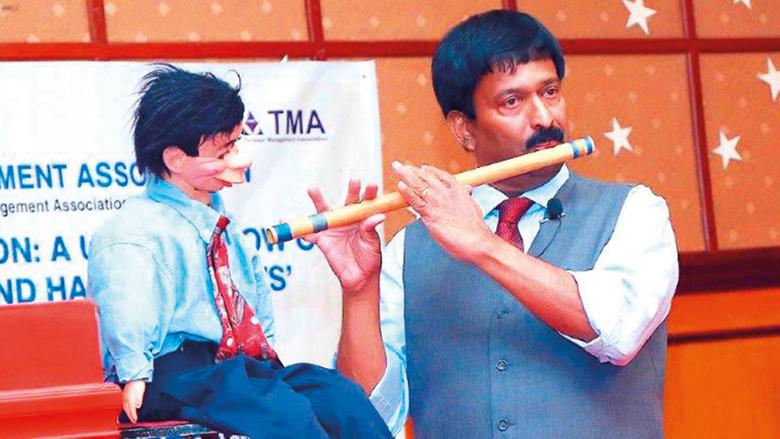
He’s happy with ventriloquism’s standing in the US and Europe, where he says it is very popular, ‘but in India no one knows it. I was hoping Dubai would be different, but no one knows it here either. The lack of exposure and opportunities is a pity. It’s a ripple effect usually – two or three people in an audience of 100 might take it up, which is good enough to carry it on. But in Dubai I’m not getting that initial audience itself.’
Instead, Sati found caricature was very popular in the UAE, so changed gears. ‘That’s getting a fantastic response; there are so many people calling for party caricatures at events and birthday parties. I’m sad about ventriloquism not picking up steam, but happy if any of my hobbies is good enough for people to adopt.’
He’s not calling it a day for the other two art forms though; he’d still like to propagate it here, admitting it’s going to be a challenging task. ‘There seems to be a mental block here for it; people are more fascinated with acrobatics, sand art etc. There’s a resistance to even try out ventriloquism and shadowgraphy.’
Even though we live in a time when most kids would rather be manoeuvring a Playstation console than their fingers into shadows, Sati doesn’t blame technology for killing off interest in these. ‘The US is a great example of this with its great response to ventriloquism, though technology is so ubiquitous there.
‘In England and France, too; hand shadows are very popular. I’d go as far as to say a lot of people are quite fed up of everything digital, so there’s nothing like going to a show; it’s a treat. Shadowgraphy or ventriloquism are not outdated visual art forms, there’s tremendous scope for it.’
Quite a few times, he’s had to field cynicism for his performances. ‘Sometimes, when people see the puppets talking, they think the act is prerecorded, and I’m playing an audio recording.’ After fielding these accusations, he started getting audiences to ask questions directly to puppets, making it more of an interactive set – and the gasps and cheers came right back. ‘Kishore in his suit is a popular puppet – ask him his age and he’ll tell you never to ask a man his age and a woman her salary. Also Shilpa the playback singer is popular too.’
A move to more audience interaction and giving puppets more character seem to have worked across the world. Ventriloquism is no longer just the distracting sideshow. Many ventriloquists have gone on to win talent shows – like 12-year-old Darci Lynne who won America’s Got Talent in 2017, and who Sati calls amazing.
How does Sati manage to seamlessly merge all the art forms during his acts? ‘I hold two puppets, they’ll ask me to do a caricature, then they’ll ask me to do some magic. Then one puppet will say to the other, I’ll sing, and you play some music. I’m a one-man army who blends and mixes to suit.’
His favourite, though, is ventriloquism. ‘There’s so much scope for it, you can add anything, there’s much variety. The puppets can have different personalities. There’s no language barrier because the basic principle is the same. I speak French, Spanish, Hindi, Tamil, Malayalam, I use all these languages, though the main medium is always English.’
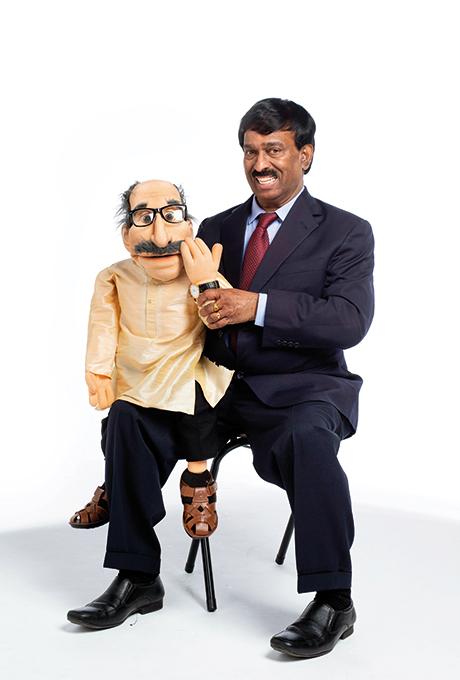
Sati isn’t secretive about how he performs; pulling the wool over the audience’s eyes is not his act. He’s eager to spread the word about these art forms to the point he is happy to share his tricks. ‘I often take the head out of the puppet and show the lever that moves the mouth and chin to people. I’ve been teaching a few youngsters in my apartment complex how to do it. I don’t want anyone to think being able to perform this is a magical power.
‘With magic, of course, I wouldn’t show the secrets behind as then the fancy is lost, the curiosity is gone.’
And making a living out of a doll isn’t as far-fetched as you might think – it is possible to throw your voice for a living. ‘If you’re lucky, yes, though not many people do,’ Sati says. ‘Yes, Jeff Dunham [an American ventriloquist and stand-up comedian who performs to sold-out arenas across the globe] has become a millionaire out of it. I won’t be able to sustain it without my job, but that’s my secret dream. I’ve now come to a reconciliation though, I have to do my job and my hobbies.’
How does he fit it all in? Sati says 24 hours isn’t enough for him to juggle between work and his hobbies, but he’s good at time management, is an early riser (4am), and never sits idle. ‘I get surprised when people say they’re bored, that word never occurs to me. There should always be something to look forward to so life doesn’t get boring. I enjoy what I do, and don’t feel pressure to do it. It’s fulfilling, there’s no external financial pressure, it’s a form of relaxation, and it feels like a blessed life.’
Has he passed on the skills to his daughter Maya, 35, like his dad did? She produces some good hand shadows, he says, and she used to perform magic ‘but once she came to know the secret of magic she lost interest. She has an aversion for ventriloquism though, because I used to make my puppets talk to my wife and her when she was a child, and I think she developed a sort of sibling rivalry! And what I couldn’t tell my wife, I’d make the puppet say. Maya developed her own interests, from [Indian classical dance] Bharatanatyam and a black belt in karate to playing piano and some voracious reading.’
Entertainment might be the end goal, but his hobbies also had one more inadvertent effect – that of saving him. He talks of how his art formed a cushion for him to grieve when his wife died four years ago after a struggle with pulmonary fibrosis. ‘She suffered a lot, about 11 years. Art was one reason that kept me going through it all, or life would have been miserable. Losing her was not easy to overcome.’
Three years back Sati decided to move back to Kerala to overcome the loneliness. ‘The social life is different there, with my brothers and sisters all around.’ He juxtaposes this with life in the US. ‘Maya, who lives in Washington, once called ahead to ask if she could come see me, requesting a certain time. I laughed and told her she had the key to the house, and she didn’t need to take an appointment with me! Even my best friends there – everybody is busy and has their own lives to lead. So I thought I was better off going back to my roots.’
Having had first-hand experience with the loneliness, he now plans on performing in old age homes or for old people. ‘That’s my goal. Elderly people are deprived of company, and often live a lonely, depressed life, so entertainment for them will help bring some joy to them.’
And that might be the crux of it all, the joy. If nothing, his art sure creates a sense of wonder, and that’s all the magic you need in the world at the moment.
For more info visit satiachath.co.in.
